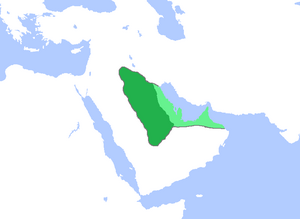عمرو بن هند
| Amr III ibn al-Mundhir | |
|---|---|
| King of the Lakhmid state | |
 | |
| العهد | CE 554–569 |
| سبقه | Al-Mundhir III |
| تبعه | Qabus ibn al-Mundhir |
| وُلِد | unknown |
| توفي | ح. 569 Najd, Lakhmid kingdom |
| البيت | Lakhmids |
| الأب | Al-Mundhir III |
| الأم | Hind bint al-Harith ibn Amr ibn Hujr Akil al-Murar |
| الديانة | Nestorian Christianity |
عمرو الثالث بن المنذر ابن امرئ القيس اللخمي من كهلان المعروف باسم عمرو بن هند ملك الحيرة في الجاهلية (توفي تقديرا 45 ق. هـ/578 م). عرف بنسبته إلى أمه هند عمة امرئ القيس الشاعر تمييزاً له عن أخيه عمرو الأصغر ابن أمامة. يلقب بالمحرّق الثاني، لإحراقه بعض بني تميم في جناية واحد منهم اسمه سويد الدارمي، قتل ابناً (أو أخاً) صغيراً لعمرو. ملك بعد أبيه. واشتهر في وقائع كثيرة مع الروم والغسانيين وأهل اليمامة. وهو صاحب صحيفة المتلمس، وقاتل طرفة بن العبد الشاعر. كان شديد البأس، كثير الفتك، هابته العرب وأطاعته القبائل. وفي أيامه ولد النبي محمد بن عبد الله صلى الله عليه وسلم. واستمر ملكه خمسة عشر عاماً. وقتله عمرو بن كلثوم الشاعر صاحب المعلقة أنفة وغضباً لأمه في خبر طويل. خلفه أخوه قابوس بن هند.
الشخصية
The Arabic sources highlight Amr's energy and warlike nature, but also his cruelty, which was legendary: according to a well-known story, he sent the poets al-Mutalammis and Tarafa to the governor of Bahrayn bearing sealed letters with orders for their execution. Al-Mutalammis was suspicious enough to destroy his letter, but Tarafa delivered his, and was executed. The "letter of al-Mutalammis" became the proverbial example of this device in Arab lore.[1][2]
Amr's difficult character earned him the nickname Muḍarriṭ al-Ḥijāra ("the one who makes stones emit sounds"), as well as Muḥarriq ("the burner").[3][4] The latter nickname is connected to a tradition reporting that he ordered a hundred members of the Tamimi subtribe of Darim burned alive. Alternatively, it is attributed to his burning the date palms of al-Jamama. The historian Gustav Rothstein notes that it is more likely that these stories are later inventions, designed to explain Amr's nickname, rather than its origin. Rothstein points out that Muharriq was a common name among the Lakhmids, and the name of a local pre-Islamic deity, so that it may simply reflect a dedication of Amr in his childhood to this cult.[5]
الذكرى الثقافية
Amr's court was renowned in Arab history for the number of poets it attracted, including Kulthum, Tarafa, al-Harith ibn Hilliza, al-Mutalammis, al-Muthaqqib al-Abdi, al-Munakhal al-Yashkuri, Suwayd ibn Khadhdhaq and Yazid ibn Khadhdhaq.[3] Amr himself was also the cousin of the greatest pre-Islamic Arab poet, Imru al-Qays.[3] At his court in al-Hira, the Arab poets were increasingly exposed to the cultural influence of the Sasanians, and his court "contributed to an urbanisation of pastoralist Arabic poetry".[3]
المراجع
- ^ Wensinck 1960, pp. 451–452.
- ^ Bosworth 1999, p. 328 (note 774).
- ^ أ ب ت ث Shahîd 2010.
- ^ Rothstein 1899, p. 95.
- ^ Rothstein 1899, pp. 46–47, 95.
المصادر
- Bosworth, C. E. (1983). "Iran and the Arabs Before Islam". In Yarshater, Ehsan (ed.). The Cambridge History of Iran: The Seleucid, Parthian, and Sasanian periods (1). Cambridge: Cambridge University Press. pp. 593–612. ISBN 978-0-521-200929.
- Bosworth, C.E., ed. (1999). The History of al-Ṭabarī, Volume V: The Sāsānids, the Byzantines, the Lakhmids, and Yemen. SUNY Series in Near Eastern Studies. Albany, New York: State University of New York Press. ISBN 978-0-7914-4355-2.
- Hoyland, Robert G. (2001). Arabia and the Arabs: From the Bronze Age to the coming of Islam. London and New York: Routledge. ISBN 0-415-19535-7.
- قالب:PLRE
- Rothstein, Gustav (1899). Die Dynastie der Lahmiden in al-Hîra. Ein Versuch zur arabisch-persichen Geschichte zur Zeit der Sasaniden [The Dynasty of the Lakhmids at al-Hira. An Essay on Arab–Persian History at the Time of the Sasanids] (in الألمانية). Berlin: Reuther & Reichard.
- Shahîd, Irfan (1995). Byzantium and the Arabs in the Sixth Century. Volume 1, Part 1: Political and Military History. Washington, DC: Dumbarton Oaks Research Library and Collection. ISBN 978-0-88402-214-5.
- Shahîd, Irfan (2010). "ʿAmr b. Hind". In Fleet, Kate; Krämer, Gudrun; Matringe, Denis; Nawas, John; Rowson, Everett (eds.). Encyclopaedia of Islam, THREE. Brill Online. doi:10.1163/1573-3912_ei3_COM_23069. ISSN 1873-9830.
- Wensinck, A. J. (1960). "ʿAmr b. Hind". In Gibb, H. A. R.; Kramers, J. H.; Lévi-Provençal, E.; Schacht, J.; Lewis, B.; Pellat, Ch. (eds.). The Encyclopaedia of Islam, New Edition, Volume I: A–B. Leiden: E. J. Brill. pp. 451–452. ISBN 90-04-08114-3.
{{cite encyclopedia}}: Invalid|ref=harv(help)
| قبله: المنذر بن ماء السماء |
مـناذرة 554-569 |
بعده: قابوس بن هند |
- Short description is different from Wikidata
- CS1 الألمانية-language sources (de)
- 569 deaths
- 6th-century Arab people
- 6th-century monarchs in the Middle East
- 6th-century murdered monarchs
- Lakhmid kings
- People of the Roman–Sasanian Wars
- Arabs from the Sasanian Empire
- Vassal rulers of the Sasanian Empire
- Year of birth unknown
- مسيحيون عرب في بلاد الرافدين